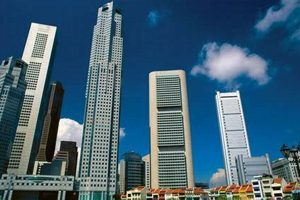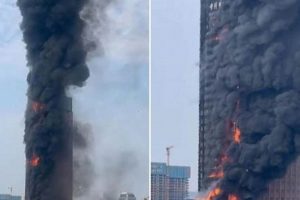Futuristic skyscrapers are a new wave of architectural design that’s pushing the boundaries of what’s possible. Featuring sustainable materials, organic shapes, and cutting-edge technology, these buildings are transforming skylines around the world.
The importance of these structures goes beyond aesthetics. They’re designed to adapt to the needs of a rapidly changing world, focusing on sustainability and offering innovative solutions to urban problems. Their unique designs can increase energy efficiency, reduce carbon emissions, promote natural light, and foster community connections.
From Dubai’s Burj Khalifa to New York City’s Hudson Yards, these buildings are shaping the future of urban living, providing a glimpse into a world where innovation and sustainability go hand-in-hand. They serve as a testament to human ingenuity and our ability to push architectural boundaries, leaving a lasting legacy for generations to come.
1. Sustainable Materials
In the realm of futuristic skyscrapers, sustainable materials play a pivotal role in shaping these architectural wonders. Their incorporation goes beyond environmental consciousness; it’s a testament to innovation and a commitment to a greener future. Sustainable materials minimize the environmental impact of skyscrapers throughout their lifecycle, from construction to operation and eventual decommissioning.
The use of sustainable materials in futuristic skyscrapers extends beyond mere aesthetics. These materials offer practical benefits, such as enhanced durability, reduced maintenance costs, and improved energy efficiency. For example, the One World Trade Center in New York City utilizes a glass faade that reduces heat gain and glare, cutting down on energy consumption for cooling.
Moreover, sustainable materials contribute to the overall sustainability goals of futuristic skyscrapers. By incorporating recycled materials, renewable resources, and low-carbon alternatives, these buildings reduce their carbon footprint and promote a circular economy. The Burj Khalifa in Dubai, the world’s tallest building, uses recycled steel and glass in its construction, demonstrating the practical implementation of sustainable materials on a massive scale.
In conclusion, sustainable materials are not just a trend in futuristic skyscrapers; they are a necessity. They reflect the growing awareness of environmental responsibility and the pursuit of innovative solutions to the challenges of urbanization. By embracing sustainability, futuristic skyscrapers pave the way for a greener, more sustainable future for our cities and the planet.
2. Organic Shapes
Futuristic skyscrapers embrace organic shapes, blurring the boundaries between architecture and nature. These forms mimic natural patterns, curves, and structures, creating visually striking and functionally efficient buildings. Organic shapes challenge traditional rectilinear designs, allowing for more fluid and dynamic structures that harmonize with their surroundings.
The incorporation of organic shapes in futuristic skyscrapers extends beyond aesthetics. These forms offer practical advantages, including enhanced structural stability, improved energy efficiency, and optimized space utilization. For instance, the CCTV Headquarters in Beijing, designed by Rem Koolhaas, features a unique loop-shaped structure that enhances its resistance to wind and seismic forces.
Moreover, organic shapes contribute to the sustainability goals of futuristic skyscrapers. By mimicking natural forms, these buildings can better integrate with their environment, reducing their impact on ecosystems and promoting biodiversity. The Bosco Verticale in Milan, designed by Stefano Boeri, incorporates lush greenery into its facade, creating a vertical forest that purifies the air and provides habitats for wildlife.
In conclusion, organic shapes are not merely a design choice in futuristic skyscrapers; they are an integral part of their identity and functionality. By embracing organic forms, architects are creating buildings that are not only visually stunning but also structurally sound, energy-efficient, and sustainable. Organic shapes are shaping the future of skyscraper design, pushing the boundaries of innovation and creating more harmonious and livable urban environments.
3. Cutting-edge technology
In the realm of futuristic skyscrapers, cutting-edge technology takes center stage, enabling these architectural marvels to transcend the boundaries of conventional design and functionality. Technology seamlessly integrates with every aspect of these structures, from their structural systems to their energy management and occupant experience.
- Structural Innovations: Futuristic skyscrapers utilize advanced materials and engineering techniques to achieve unprecedented heights and structural stability. For instance, the Shanghai Tower employs a unique double-skin facade and a concrete core reinforced with carbon fiber, allowing it to withstand high winds and seismic activity.
- Energy Efficiency: Cutting-edge technology contributes to the sustainability of futuristic skyscrapers. Smart building systems optimize energy consumption by monitoring and controlling lighting, heating, and cooling systems. The Taipei 101 skyscraper, for instance, utilizes a wind turbine system and rainwater harvesting to reduce its environmental impact.
- Intelligent Facades: Futuristic skyscrapers incorporate dynamic facades that respond to environmental conditions. These facades use sensors and actuators to adjust their transparency, shading, and ventilation, maximizing natural light and minimizing energy consumption. The Al Bahar Towers in Abu Dhabi feature a kinetic facade that opens and closes in response to sunlight, creating a visually stunning and energy-efficient building envelope.
- Vertical Transportation: Advanced elevators and transportation systems are essential in futuristic skyscrapers. These systems utilize magnetic levitation, AI-powered algorithms, and destination-based dispatch to enhance speed, efficiency, and passenger comfort. The Burj Khalifa, the world’s tallest building, boasts a double-decker elevator system that travels at over 10 meters per second.
The integration of cutting-edge technology in futuristic skyscrapers is not merely a pursuit of novelty; it is a driving force behind their sustainability, functionality, and overall appeal. These technological advancements are shaping the future of urban architecture, creating intelligent, responsive, and sustainable landmarks that meet the demands of a rapidly evolving world.
4. Energy effici
ency
Energy efficiency is a critical consideration in the design and operation of futuristic skyscrapers. These towering structures consume a significant amount of energy, making it imperative to adopt sustainable practices to reduce their environmental impact and operating costs. Several key facets contribute to the energy efficiency of futuristic skyscrapers:
- Advanced building envelope: The building envelope, including the facade, windows, and roof, plays a crucial role in regulating energy consumption. Futuristic skyscrapers incorporate high-performance glazing, dynamic insulation systems, and shading devices that minimize heat gain and loss, reducing the need for heating and cooling.
- Smart lighting systems: LED lighting and intelligent control systems enable precise lighting management, reducing energy waste. Occupancy sensors, daylight harvesting, and automated dimming adjust lighting levels based on occupancy and available natural light, optimizing energy consumption.
- Efficient HVAC systems: Heating, ventilation, and air conditioning (HVAC) systems account for a significant portion of energy use in skyscrapers. Futuristic skyscrapers employ advanced HVAC technologies, such as variable air volume systems, heat recovery systems, and geothermal heating and cooling, to minimize energy consumption while maintaining occupant comfort.
- Renewable energy sources: Futuristic skyscrapers are increasingly integrating renewable energy sources, such as solar panels and wind turbines, into their designs. These systems generate clean energy, reducing reliance on fossil fuels and further enhancing the sustainability of these structures.
By incorporating these energy-efficient measures, futuristic skyscrapers can significantly reduce their energy consumption, contributing to a more sustainable and eco-friendly urban environment. These advancements not only minimize operating costs but also align with the growing demand for green buildings and responsible energy management practices.
5. Reduced carbon emissions
In the realm of futuristic skyscrapers, reducing carbon emissions is a critical imperative, driven by the need to mitigate climate change and create sustainable urban environments. Futuristic skyscrapers, with their sheer height and complex systems, have the potential to be significant contributors to greenhouse gas emissions. However, architects and engineers are employing innovative strategies to minimize the carbon footprint of these structures.
- Energy-efficient design: Futuristic skyscrapers incorporate energy-efficient features throughout their design, such as high-performance building envelopes, smart lighting systems, and efficient HVAC systems. These measures reduce energy consumption, leading to lower carbon emissions.
- Renewable energy sources: Many futuristic skyscrapers are integrating renewable energy sources, such as solar panels and wind turbines, into their designs. These systems generate clean energy, reducing reliance on fossil fuels and further minimizing carbon emissions.
- Sustainable materials: Futuristic skyscrapers often utilize sustainable materials, such as recycled steel and low-carbon concrete, which have a lower embodied carbon footprint compared to traditional materials.
- Carbon capture technologies: Some futuristic skyscraper designs incorporate carbon capture and storage technologies, which remove carbon dioxide from the atmosphere, further reducing their carbon emissions.
By implementing these strategies, futuristic skyscrapers can significantly reduce their carbon emissions, contributing to a more sustainable and eco-friendly urban environment. These advancements not only align with the growing demand for green buildings but also demonstrate the commitment of architects and engineers to creating a more sustainable future.
6. Natural light
Natural light plays a pivotal role in the design and experience of futuristic skyscrapers, offering numerous benefits that enhance the well-being of occupants and contribute to the overall sustainability of these structures.
- Enhanced occupant well-being: Natural light has been shown to have a positive impact on human health and well-being. It regulates circadian rhythms, improves mood, and reduces stress levels. Futuristic skyscrapers incorporate large windows and skylights to maximize natural light penetration, creating healthier and more comfortable indoor environments.
- Reduced energy consumption: Natural light can significantly reduce the need for artificial lighting, leading to lower energy consumption. Futuristic skyscrapers utilize intelligent lighting systems that automatically adjust to available daylight, optimizing energy efficiency.
- Improved indoor air quality: Natural ventilation, facilitated by operable windows and skylights, allows for the circulation of fresh air, reducing indoor air pollution and improving the overall air quality within futuristic skyscrapers.
- Enhanced aesthetic appeal: Natural light creates visually stunning and dynamic interiors. Futuristic skyscrapers often feature floor-to-ceiling windows that offer panoramic views of the surrounding cityscape, enhancing the aesthetic appeal of these structures.
By embracing natural light, futuristic skyscrapers not only provide a healthier and more sustainable environment for their occupants but also create visually captivating and iconic landmarks that contribute to the vibrancy of urban landscapes.
7. Community connections
Futuristic skyscrapers are not merely architectural marvels; they are also social and cultural hubs that have the potential to strengthen community connections and foster a sense of belonging. By incorporating innovative design elements and community-oriented amenities, futuristic skyscrapers can create vibrant and inclusive urban environments.
One of the key ways in which futuristic skyscrapers promote community connections is through the creation of public spaces. Sky gardens, rooftop terraces, and communal plazas provide opportunities for residents and visitors to interact, socialize, and enjoy shared experiences. These spaces can host events, workshops, and gatherings, fostering a sense of community and belonging.
Futuristic skyscrapers can also facilitate community connections through mixed-use developments. By integrating residential, commercial, and cultural spaces within a single building, these structures create a diverse and dynamic environment where people from all walks of life can live, work, and socialize. This mix of uses encourages interaction and collaboration, breaking down barriers and fostering a sense of community.
Moreover, futuristic skyscrapers can incorporate sustainable design features
that promote community well-being and encourage social interaction. Green roofs and vertical gardens not only improve air quality and reduce the urban heat island effect but also create shared spaces where residents can connect with nature and each other.
By embracing community connections, futuristic skyscrapers can create more livable, sustainable, and vibrant urban environments. These structures have the potential to transform cities into thriving communities where people feel connected, engaged, and empowered.
8. Urban problem-solving
Futuristic skyscrapers have emerged as potential solutions to various urban challenges, offering innovative approaches to address issues related to population growth, environmental sustainability, and social equity.
- Vertical expansion: As cities become increasingly dense, futuristic skyscrapers provide a means to accommodate growing populations without sprawling urban boundaries. By building upwards, these structures maximize land use and reduce urban sprawl, preserving green spaces and promoting compact city development.
- Sustainable design: Futuristic skyscrapers incorporate sustainable design principles to mitigate their environmental impact. Green roofs, rainwater harvesting systems, and energy-efficient facades help reduce water consumption, lower carbon emissions, and improve air quality, contributing to a more sustainable urban environment.
- Mixed-use developments: By integrating residential, commercial, and cultural spaces within a single building, futuristic skyscrapers create vibrant and inclusive communities. This mixed-use approach reduces the need for extensive commuting, promotes walkability, and fosters social interaction, ultimately enhancing urban livability.
- Resilience and adaptability: Futuristic skyscrapers are designed with resilience and adaptability in mind, enabling them to withstand extreme weather events and other urban challenges. Advanced building materials, structural systems, and emergency response plans ensure the safety and well-being of occupants during crises.
Futuristic skyscrapers offer a glimpse into the future of urban living, demonstrating the potential to address complex urban problems through innovative design and technological advancements. By embracing sustainability, vertical expansion, mixed-use developments, and resilience, these structures contribute to the creation of more livable, sustainable, and equitable cities.
FAQs on Futuristic Skyscrapers
Futuristic skyscrapers are architectural marvels that push the boundaries of design and innovation. They offer potential solutions to various urban challenges, but also raise questions and concerns. Here are answers to some frequently asked questions about futuristic skyscrapers:
Question 1: Are futuristic skyscrapers environmentally sustainable?
Yes, many futuristic skyscrapers incorporate sustainable design principles to minimize their environmental impact. They utilize green roofs, rainwater harvesting systems, and energy-efficient facades to reduce water consumption, lower carbon emissions, and improve air quality.
Question 2: How do futuristic skyscrapers address urban density?
Futuristic skyscrapers provide a means to accommodate growing populations without sprawling urban boundaries. By building upwards, these structures maximize land use and reduce urban sprawl, preserving green spaces and promoting compact city development.
Question 3: Are futuristic skyscrapers safe and resilient?
Futuristic skyscrapers are designed with resilience and adaptability in mind to withstand extreme weather events and other urban challenges. Advanced building materials, structural systems, and emergency response plans ensure the safety and well-being of occupants during crises.
Question 4: How do futuristic skyscrapers promote social equity?
By integrating residential, commercial, and cultural spaces within a single building, futuristic skyscrapers create vibrant and inclusive communities. This mixed-use approach reduces the need for extensive commuting, promotes walkability, and fosters social interaction, ultimately enhancing urban livability.
Question 5: Are futuristic skyscrapers accessible to all?
Accessibility is a crucial consideration in the design of futuristic skyscrapers. Many incorporate features such as ramps, elevators, and accessible entrances to ensure that people with disabilities have equitable access to all levels and amenities of the building.
Question 6: How do futuristic skyscrapers contribute to urban aesthetics?
Futuristic skyscrapers are often iconic landmarks that shape the identity of a city. Their unique designs and innovative facades create visual interest and enhance the overall aesthetic appeal of the urban environment.
In summary, futuristic skyscrapers offer a glimpse into the future of urban living, demonstrating the potential to address complex urban problems through innovative design and technological advancements. By embracing sustainability, vertical expansion, mixed-use developments, resilience, and accessibility, these structures contribute to the creation of more livable, sustainable, and equitable cities.
Moving on to the next section…
Tips on Futuristic Skyscrapers
Futuristic skyscrapers, with their innovative designs and advanced technologies, offer a glimpse into the future of urban living. Here are some tips to consider when designing and constructing these architectural marvels.
Tip 1: Embrace Sustainability
Incorporate sustainable design principles to minimize environmental impact. Utilize green roofs, rainwater harvesting systems, and energy-efficient facades to reduce water consumption, lower carbon emissions, and improve air quality.
Tip 2: Prioritize Vertical Expansion
Maximize land use and reduce urban sprawl by building upwards. Futuristic skyscrapers can accommodate growing populations without sacrificing green spaces or promoting urban sprawl.
Tip 3: Design for Mixed-Use Developments
Create vibrant and inclusive communities by integrating residential, commercial, and cultural spaces within a single building. This approach reduces commuting, promotes walkability, and fosters social interaction.
Tip 4: Ensure Resilience and Adaptability
Incorporate resilient design features to withstand extreme weather events and other urban challenges. Utilize advanced building materials, structural systems, and emergency response plans to ensure the safety and well-being of occupants during crises.
Tip 5: Enhance Accessibility and Inclusivity
Ensure that futuristic skyscrapers are accessible to all. Incorporate ramps, elevators, and accessible entrances to provide equitable access for people with disabilities to all levels and amenities of the building.
Tip 6: Consider Urban Aesthetics
Design futuristic skyscrapers that are not only functional but also visually appealing. Unique designs and innovative facades can create iconic landmarks that enhance the overall aesthetic appeal of the urban environment.
By following these tips, architects and engineers can create futuristic skyscrapers that are not only architectural wonders but also sustainable, resilient, inclusive, and aesthetically pleasing. These structures have the potential to transform cit
ies into more livable, sustainable, and equitable environments for future generations.
Proceeding to the conclusion…
Conclusion
Futuristic skyscrapers represent a bold vision for the future of urban living. By embracing sustainable design, vertical expansion, mixed-use developments, resilience, and inclusivity, these architectural marvels offer potential solutions to complex urban challenges.
As cities continue to grow and evolve, futuristic skyscrapers have the potential to transform the way we live, work, and interact with our urban environments. They serve as beacons of innovation and sustainability, pushing the boundaries of architectural design and redefining the skyline of the future. By embracing these innovative concepts, we can create more livable, sustainable, and equitable cities for generations to come.







